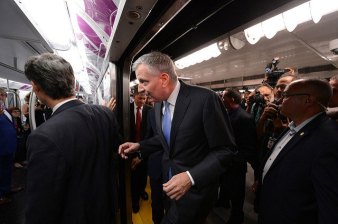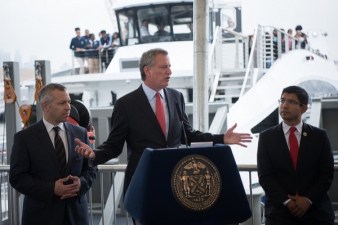Newsday Endorses Move NY for 2016, While the Times Misses Its Chance
Two of the region’s papers laid out their Albany 2016 agendas in New Year’s weekend editorials. Both led with ethics reform, but the similarities ended there. One paper boldly called on the legislature to “adopt some version of the innovative Move NY tolling-and-congestion pricing plan.” The other was silent on transit and traffic, even as it spurred Gov. Andrew Cuomo to “lead on climate change.”
The Move NY endorser was — drumroll — Newsday. Its editorial, Here’s what we want from Albany in 2016, was the Long Island paper’s third effusive endorsement of the Move NY plan in two years:
Adopt some version of the innovative Move NY tolling-and-congestion pricing plan that would toll East River bridges, reduce tolls on other bridges, and charge people to drive into midtown Manhattan. It would reduce congestion, get more people to take public transit, and provide $1.5 billion per year for badly-needed transportation infrastructure.
Newsday’s number one transit priority is the LIRR’s long-sought third track between Queens Village and Hicksville to allow expanded local and reverse-peak service in Nassau and Suffolk counties once East Side Access is completed. But the paper left no doubt that it gets the importance of the Move NY plan’s promised congestion reduction and transit funding for the entire region.
The other paper, the one giving Cuomo a pass on transportation pricing and infrastructure, was the Times. Rather than spell out traffic and transit solutions, the editorial, Mr. Cuomo’s Challenges: The Short List, offered only lofty sentiments on climate change:
Mr. Cuomo has shown leadership on issues of national and even global importance, including climate change. He has already announced a goal of having half of the state’s power generated by renewable sources like wind and solar by 2030, and he has ordered state regulators to draw up rules to make that happen. He clearly wants to position New York as a co-leader with California in the fight.
The ironies are dizzying:
- The Times ran at least a dozen editorials backing Mayor Bloomberg’s congestion pricing plan, like this one from February, 2008. Yet it has barely editorialized in favor of the Move NY plan.
- The 2030 target date for 50 percent renewable power is far enough away that politicians (and editorial boards) can declare mission accomplished without having to take on the hard work of defeating the inevitable NIMBYs and providing economic incentives like carbon taxes. Yet the Move NY plan could be unclogging traffic and generating funds for transit within a few years.
- The 50 percent target itself is oddly framed. The electricity policy objective that best protects climate isn’t necessarily one that maximizes solar and wind but that minimizes and eliminates carbon fuels, period. Even if renewables do end up supplying half the state’s electricity in 2030, if total usage rises by just 2 percent a year our carbon emissions from electricity will have fallen by only one-fourth.
- Unless the MTA is given resources to improve and expand service, subway crowding and delays will likely worsen, impeding New York City’s ability to maintain its robust growth in population and employment. That would undermine the state and national carbon-reduction agenda: every new job and household forced to the Sunbelt — or any sprawling outer-suburban ring — will lock in five to ten times more energy requirements and carbon emissions than if the same development takes place in “inherently green” New York City.
The last point is well established by now. Over the past quarter-century, a wave of scholarship starting with Newman and Kenworthy’s Sustainability and Cities: Overcoming Automobile Dependence and long-form journalism like David Owen’s Green Metropolis have established that, in Owen’s words, “living smaller, living closer, and driving less are the keys to sustainability.” Indeed, that body of work underlies the emerging consensus, on notable display at the UN climate summit in Paris, that the solution to climate change lies in the low-carbon social and economic organization of cities.
In short, the governor’s and the Times’ wind turbines and solar farms and rooftops, while welcome and vital, won’t suffice to make the state of New York a climate change leader. Humane and efficient transit enabling the region’s core to thrive is at least as vital.
The number one sustainability question before Albany and City Hall is how they’ll fund their respective $8.3 billion and $2.5 billion contributions to the MTA capital plan promised by Cuomo and Mayor de Blasio last fall. Will they take money from other pressing needs or, worse, borrow the funds, setting off another fare hike spiral? Or will they shake hands around a plan built on smart economic incentives like Move NY? Let’s hope the Times’ next editorial frames the climate issue that way.

